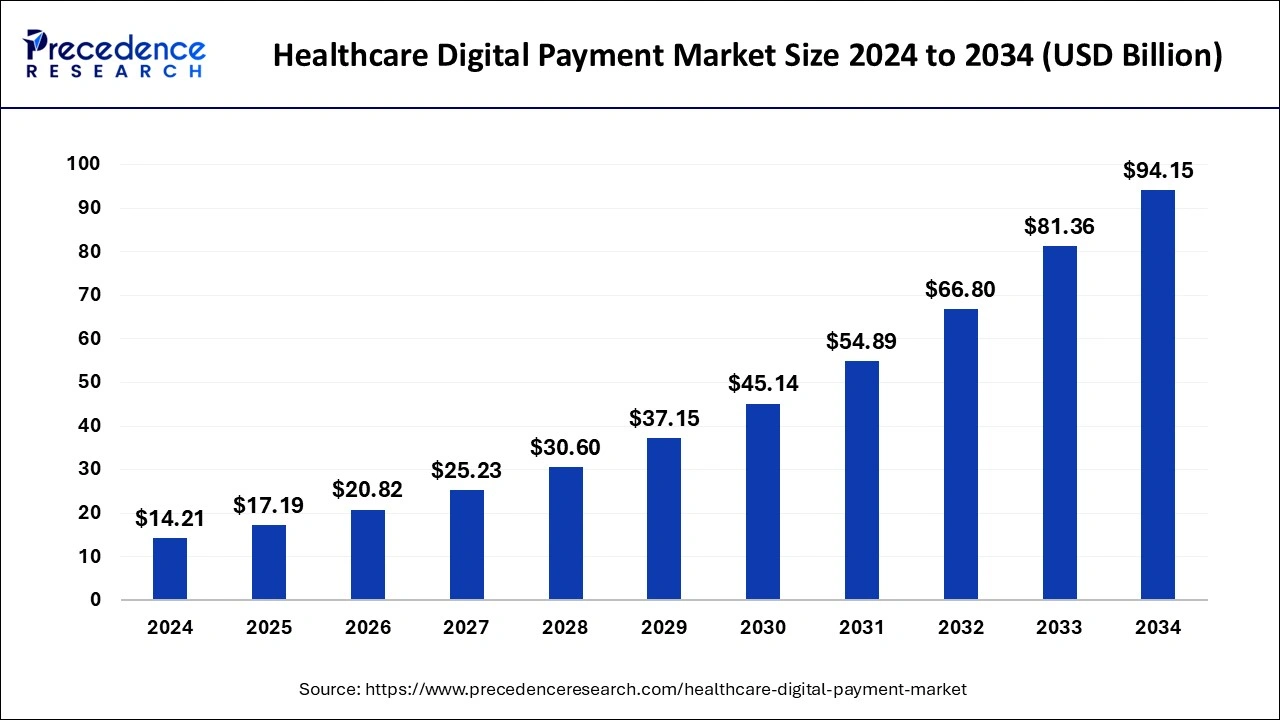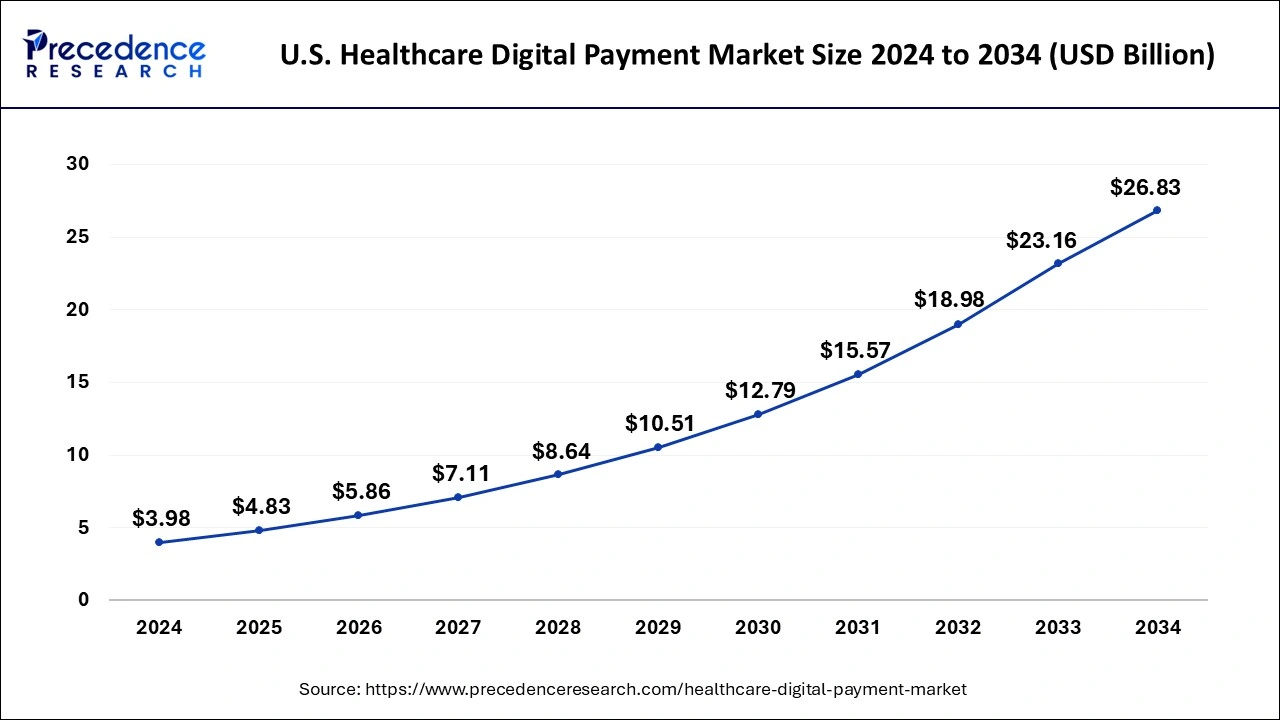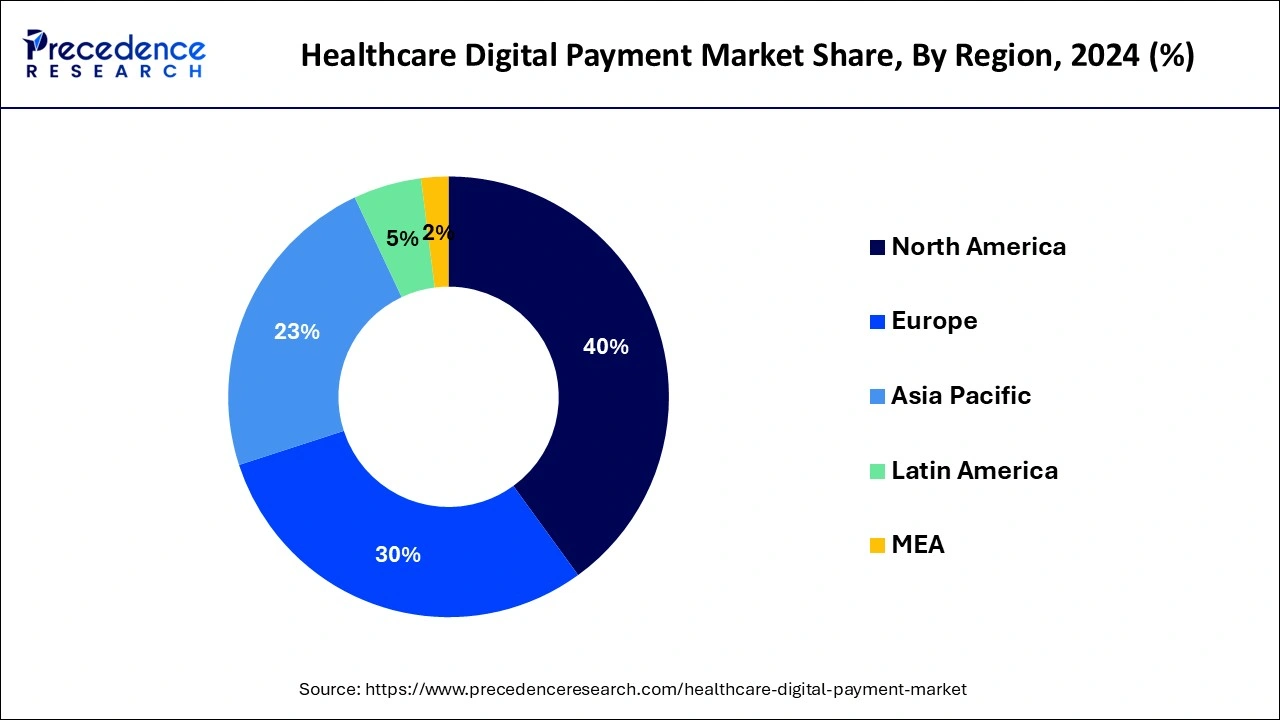Healthcare Digital Payment Market Size and Forecast 2025 to 2034
The global healthcare digital payment market size was estimated at USD 14.21 billion in 2024 and is predicted to increase from USD 17.19 billion in 2025 to approximately USD 94.15 billion by 2034, expanding at a CAGR of 20.82% from 2025 to 2034.

Healthcare Digital Payment MarketKey Takeaways
- The global healthcare digital payment market was valued at USD 14.21 billion in 2024.
- It is projected to reach USD 94.15 billion by 2034.
- The market is expected to grow at a CAGR of 20.82% from 2025 to 2034.
- North America dominated the global market with the largest market share of 40% in 2024.
- Asia-Pacific is estimated to expand at the fastest CAGR between 2025 and 2034.
- By solution, the payment processing segment held the biggest market share of 23% in 2024.
- By solution, the payment gateway segment is anticipated to grow at a remarkable CAGR of 23.5% between 2025 and 2034.
- By deployment, the cloud segment generated over 53% of the market share in 2024.
- By deployment, the on-premise segment is expected to expand at the fastest CAGR over the projected period.
- By mode of payment, the bank cards segment generated over 34% of the market share in 2024.
- By mode of payment, the digital wallet segment is expected to expand at the fastest CAGR over the projected period.
U.S.Healthcare Digital Payment Market Size and Growth 2025 to 2034
The U.S. healthcare digital payment market size was exhibited at USD 3.98 billion in 2024 and is projected to be worth around USD 26.83 billion by 2034, growing at a CAGR of 21.02% from 2025 to 2034.

North America held the largest revenue share of 40% in 2024due to its advanced healthcare infrastructure, widespread technology adoption, and strong emphasis on digital transformation. The region's well-established regulatory framework and high patient awareness contribute to the significant market share. Furthermore, the presence of key players, robust financial systems, and a proactive approach towards healthcare innovation position North America at the forefront of digital payment adoption in the healthcare sector, driving its major share in the market.

Asia-Pacific is poised for rapid growth in the healthcare digital payment market due to expanding digital infrastructure, increasing smartphone penetration, and a rising demand for convenient and contactless transactions. With a large population accessing healthcare services, the adoption of digital payment methods is becoming crucial. Government initiatives, coupled with a growing tech-savvy population, create a favorable environment for the widespread acceptance of healthcare digital payments, driving the market's accelerated growth in the Asia-Pacific region.
Meanwhile, Europe is experiencing notable growth in the healthcare digital payment market due to the increasing adoption of digital technologies, rising demand for streamlined healthcare services, and favorable regulatory initiatives. The region's advanced infrastructure supports the integration of digital payment solutions into healthcare systems, providing patients with convenient and secure ways to manage medical expenses. Additionally, a growing awareness of the benefits, such as efficiency and accessibility, is driving the acceptance of healthcare digital payments, contributing to the market's significant expansion in Europe.
Market Overview
Healthcare digital payment refers to the electronic transfer of funds for medical services, treatments, or products using online platforms or electronic devices. In simple terms, it means paying for healthcare expenses through digital methods like credit cards, mobile apps, or online banking, eliminating the need for traditional paper-based transactions. This modern payment approach enhances convenience for patients by allowing them to settle medical bills securely and swiftly from the comfort of their homes.
It also streamlines administrative processes for healthcare providers, reducing paperwork and the likelihood of errors. Overall, healthcare digital payment aims to make financial transactions in the medical industry more efficient, transparent, and accessible, contributing to a smoother and more patient-friendly healthcare experience.
Healthcare Digital Payment MarketGrowth Factors
- Continuous advancements in technology, including secure payment gateways, blockchain, and biometric authentication, enhance the reliability and security of healthcare digital payment systems, fostering growth in the market.
- The increasing costs of healthcare services globally drive the demand for more efficient and streamlined payment processes. Digital payment solutions offer a convenient and transparent way for patients to handle medical expenses, contributing to market growth.
- Growing consumer preference for convenient and contactless transactions is a significant driver. Digital payment methods provide patients with the flexibility to make payments remotely, reducing the need for in-person transactions and paperwork.
- Governments worldwide are promoting digital healthcare initiatives and implementing regulations to encourage the adoption of electronic payment systems. These initiatives create a supportive environment for the growth of healthcare digital payments.
- The integration of digital payment solutions with electronic health records streamlines the overall healthcare experience. Patients can seamlessly settle bills and manage financial aspects of their healthcare within the same digital ecosystem, driving market expansion.
- Healthcare providers embracing digital platforms and incorporating digital payment options into their systems contribute significantly to market growth. As more healthcare institutions adopt and promote these solutions, patients are more likely to adopt digital payment methods for their healthcare transactions.
Market Scope
| Report Coverage | Details |
| Growth Rate from 2025 to 2034 | CAGR of 20.82% |
| Market Size in 2025 | USD 17.19 Billion |
| Market Size by 2034 | USD 94.15 Billion |
| Base Year | 2024 |
| Forecast Period | 2025 to 2034 |
| Segments Covered | Solution, Deployment, and Mode of Payment |
| Regions Covered | North America, Europe, Asia-Pacific, Latin America, and Middle East & Africa |
Market Dynamics
Driver
Rise of mobile wallets
- PYMNTS noted that 15.5% of payments made through mobile wallets were for healthcare services.
The rise of mobile wallets has significantly surged the demand for healthcare digital payment solutions due to increased convenience and accessibility. Mobile wallets, such as Apple Pay, Google Pay, and others, offer a user-friendly and secure platform for individuals to manage and pay for their healthcare expenses. With the widespread adoption of smartphones, users find it easy to store their payment information in these digital wallets, streamlining the payment process for medical services. Patients now prefer the simplicity of using mobile wallets, as they eliminate the need for physical cards or cash transactions.
The seamless integration of mobile wallets with healthcare payment systems allows individuals to settle medical bills effortlessly, fostering a more efficient and patient-friendly experience. This trend aligns with the broader shift towards digital transactions, reflecting the growing reliance on technology for managing financial aspects of healthcare services.
Restraint
Resistance to change
Resistance to change serves as a significant restraint on the market demand for healthcare digital payment solutions. In traditional healthcare systems, there is a longstanding reliance on manual and paper-based processes for billing and payments. The reluctance of both healthcare providers and patients to depart from these familiar methods hinders the widespread adoption of digital payment technologies. Healthcare professionals may be resistant to altering established routines, which can slow down the integration of digital payment systems.
Similarly, patients accustomed to conventional payment methods may be hesitant to embrace new, digital alternatives. This resistance stems from concerns about the learning curve associated with using unfamiliar technologies and a general aversion to disrupting established practices. Overcoming this resistance necessitates effective education and awareness campaigns to highlight the benefits of healthcare digital payments, emphasizing convenience, efficiency, and improved overall healthcare experiences for both providers and patients.
Opportunity
E-commerce integration
- The US Census Bureau reported that e-commerce sales constituted 14.7% of total revenues in Q4 2022.
E-commerce integration is generating significant opportunities for the healthcare digital payment market by streamlining and enhancing the overall patient experience. The integration of digital payment solutions into healthcare platforms enables patients to seamlessly manage and pay for medical services online. This convenience aligns with the broader trend of increasing e-commerce activities, making it easier for individuals to handle their healthcare transactions in a secure and user-friendly digital environment.
Moreover, as patients become more accustomed to digital transactions through e-commerce platforms, the healthcare industry can capitalize on this familiarity to drive the adoption of digital payment methods. The incorporation of digital payments into e-commerce ecosystems not only offers a more efficient way for patients to settle bills but also opens avenues for innovative services and features, fostering a positive environment for the growth of healthcare digital payment solutions.
Solution Insights
The payment processing segment held the highest market share of 23% in 2024. In the healthcare digital payment market, the payment processing segment encompasses the technology and systems involved in securely managing financial transactions related to healthcare services. This includes handling payments, managing billing information, and ensuring compliance with healthcare financial regulations through digital means. Recent trends in payment processing for healthcare digital payments involve the integration of real-time processing, ensuring swift and accurate financial transactions.
Additionally, there's a growing emphasis on incorporating advanced security measures such as tokenization to safeguard sensitive payment information, enhancing overall trust in digital payment solutions within the healthcare sector.
The payment gateway segment is anticipated to witness rapid growth at a significant CAGR of 23.5% during the projected period. In the healthcare digital payment market, the payment gateway segment refers to the technology that facilitates secure and seamless financial transactions between patients, healthcare providers, and insurance companies. Payment gateways play a crucial role in encrypting sensitive data, ensuring privacy compliance, and authorizing transactions.
A notable trend in this segment involves the integration of advanced security features, such as tokenization and biometric authentication, to enhance data protection. Additionally, the adoption of cloud-based payment gateways is on the rise, providing scalable and flexible solutions for healthcare organizations to manage transactions efficiently.
Deployment Insights
The cloud segment has held a 53% market share in 2024. In the healthcare digital payment market, the cloud segment refers to the deployment of digital payment solutions on cloud-based platforms. Cloud deployment enables secure storage and access to financial and health data, facilitating seamless transactions. Current trends indicate a growing preference for cloud-based solutions in healthcare, driven by their scalability, cost-effectiveness, and ability to support advanced analytics. This shift allows healthcare organizations to leverage cloud infrastructure for efficient and flexible healthcare digital payment processes, contributing to improved accessibility and data management in the industry.
The on-premise segment is anticipated to witness rapid growth over the projected period. The on-premise segment in the healthcare digital payment market refers to the deployment of payment solutions hosted locally within healthcare institutions. This deployment model involves installing and maintaining payment infrastructure on-site, providing organizations with direct control over security and customization. Trends in the on-premise segment include a continued preference among some healthcare providers for maintaining sensitive financial data within their premises, ensuring compliance with regulatory standards. While cloud-based solutions gain popularity, on-premise deployments persist, particularly for institutions prioritizing data control and security.
Mode of Payment Insights
The bank cards segment has held 34% market share in 2024. In the healthcare digital payment market, the bank cards segment refers to transactions facilitated through debit and credit cards. This mode of payment offers a secure and convenient way for patients to settle medical bills. Trends indicate a growing preference for bank cards, with an increasing number of consumers opting for the simplicity and speed of card transactions. The widespread use of bank cards underscores the importance of seamless and reliable digital payment options in the healthcare sector, contributing to the overall evolution of payment methods within the industry.
The digital wallet segment is anticipated to witness rapid growth over the projected period. The digital wallet segment in healthcare digital payments refers to transactions conducted through mobile applications or online platforms, allowing users to store and manage payment information securely. This segment is witnessing a rising trend as patients increasingly prefer the convenience of digital wallets for settling healthcare bills. With the growing ubiquity of smartphones, digital wallets streamline payment processes, offering features such as quick transactions, enhanced security, and accessibility. The trend indicates a shift towards a more seamless and user-friendly payment experience within the healthcare industry.
Recent Developments
- In August 2020, JPMorgan Chase & Co. strategically acquired InstaMed, a healthcare payment solution provider. This move aimed to enhance payment experiences for payers, healthcare providers, and consumers, aligning with the growing trend of digitalization in the healthcare payment sector.
- In July 2023, technology company Zelis partnered with Rectangle Health, a financial technology firm specializing in software solutions for healthcare organizations. This collaboration aimed to leverage technology to improve financial processes within the healthcare industry.
- In June 2023, PayPal Holdings, Inc. and global investment firm KKR entered into an exclusive multi-year agreement, involving a significant replenishing loan commitment of EUR 3 billion. This partnership focused on supporting buy now, pay later (BNPL) services across several European countries, demonstrating the expanding role of digital finance in consumer transactions.
- In February 2023, HDFC Bank initiated a pilot in collaboration with Crunchfish to test offline digital payments for merchants and customers under the RBI's Regulatory Sandbox Program, known as OfflinePay, showcasing efforts to explore innovative payment solutions.
- In November 2022, Mastercard announced a long-term strategic partnership with the Arab African International Bank (AAIB) to accelerate the digital transformation of Egypt's financial ecosystem. This collaboration aimed to implement AAIB's digital transformation strategy and provide advanced payment solutions, meeting the growing consumer demand for secure and straightforward digital payment methods in the region.
Healthcare Digital Payment Market Companies
- JPMorgan Chase & Co.
- InstaMed
- Zelis
- Rectangle Health
- PayPal Holdings, Inc.
- KKR (Kohlberg Kravis Roberts & Co.)
- HDFC Bank
- Crunchfish
- Mastercard
- Arab African International Bank (AAIB)
- Visa Inc.
- Cerner Corporation
- Fiserv, Inc.
- Allscripts Healthcare Solutions, Inc.
- Optum, Inc.
Segments Covered in the Report
By Solution
- Application Program Interface
- Payment Gateway
- Payment Processing
- Payment Security & Fraud Management
- Transaction Risk Management
- Others
By Deployment
- Cloud
- On-premise
By Mode of Payment
- Bank Cards
- Digital Wallets
- Net Banking
- Others
By Geography
- North America
- Europe
- Asia-Pacific
- Latin America
- Middle East and Africa
For inquiries regarding discounts, bulk purchases, or customization requests, please contact us at sales@precedenceresearch.com
Frequently Asked Questions
Ask For Sample
No cookie-cutter, only authentic analysis – take the 1st step to become a Precedence Research client
 sales@precedenceresearch.com
sales@precedenceresearch.com
 +1 804-441-9344
+1 804-441-9344